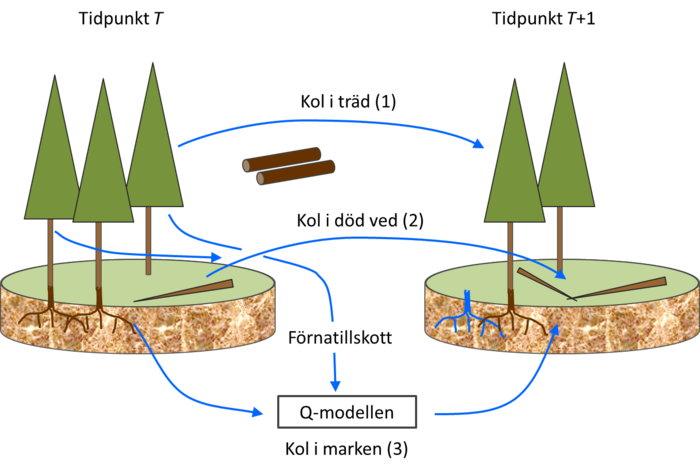Carbon sequestration
Heureka enables quantifying carbon pools in living and dead trees as well as soil, for each projection timestep (Figure 1). Ground layer carbon is not considered in Heureka at present. Changes in carbon stock over time depent on harvesting followed by extraction, emission via decomposition and capturing via photosynthesis/growth.
(1) Carbon stock in the above ground tree layer is calculated using single-tree biomass functions. In mature stands both [1] and [2] are available for usage in Heureka, whereas [3] is used for young stands. Conversion factors from biomass (dry matter) to carbon (percent of dry matter) are then used to estimate the carbon stock[4].
| Tree part | Spruce | Pine | Birch |
| Stem | 48.0 | 48.8 | 49.0 |
| Branch | 50.8 | 51.2 | 49.0 |
| Needles/leaves | 48.6 | 51.2 | 49.0 |
Other broadleaf species are calculated using birch functions, calibrated for each species wood density relative to birch([1]). Cut trees are removed from the tree layer and their felling residues (unextracted trees and parts) are transferred to the dead wood and/or soil carbon model, along with unextracted trees dead due to natural mortality.
(2) Carbon stock in dead wood is a function of starting stock, supply of dead stem wood from natural mortality as well as unextracted cut stems and stem parts (e.g. high stumps), and loss due to decomposition. If the initial dead wood stock is unknown the initial stock is simulated based on National Forest Inventory data (settings in control table Dead Wood). Decomposition of biomass is calculated using power functions (e-kt) where tree species-specific k-values can be adjusted in the control table.
(3) Soil carbon dynamics on mineral soils include biomass stock, supply and loss in stumps, roots and litter. Litter fall is calculated based on standing woody biomass, unextracted biomass after forest management activities and parts - other than stems - of trees dead from natural mortality. Stump and root biomass is calculated using [5]. These models include roots thicker than 2 mm. Fine roots (< 2mm) are calculated internally using estimated relations between intermediate (2-5 mm) and fine (<2 mm) roots, but not presented as a result variable. No biomass functions for stumps and roots in young forests are currently available for use in Heureka.
The Q-model is used to calculate the amount of carbon and nitrogen in the litter and soil layers on mineral soils, and to predict decomposition in different litter fractions. On ditched organic soils (peat), soil carbon decreases over time (using emission factors), while the soil carbon stock in unditched peatland remains constant (default 896 ton C/ha) over time. The model for peat has settings for boreal and temperate forests. A forest is considered boreal for CountyCode 1-13.
- ↑ Marklund, Lars Gunnar (1988). Biomass functions pine, spruce and birch in Sweden. Report 45. Department of Forest Survey. Swedish University of Agricultural Sciences. ISBN 91-576-3524-2
- ↑ Petersson, Hans (1999). Biomassafunktioner för trädfaktorer av tall, gran och björk i Sverige. Umeå: Fakulteten för skogsvetenskap > Institutionen för skoglig resurshushållning, Sveriges lantbruksuniversitet. Arbetsrapport / Sveriges lantbruksuniversitet, Institutionen för skoglig resurshushållning och geomatik ; 59
- ↑ Claesson, S., Sahlén, K. & Lundmark, T. 2001. Functions for biomass estimation of young Pinus sylvestris , Picea abies and Betula spp. from stands in northern Sweden with high stand densities. Scandinavian Journal of Forest Research 16: 138-146.
- ↑ Skogsstyrelsen, 2000. Skogliga Konsekvensanalyser 1999. Skogsstyrelsen, Jönköping. Rapport 2, s. 67.
- ↑ Petersson, H. & Ståhl, G. 2006. Functions for below-ground biomass of Pinus sylvestris, Picea abies, Betula pendula and Betula pubescens in Sweden. Scandinavian Journal of Forest Research 21(Suppl 7): 84-93.
